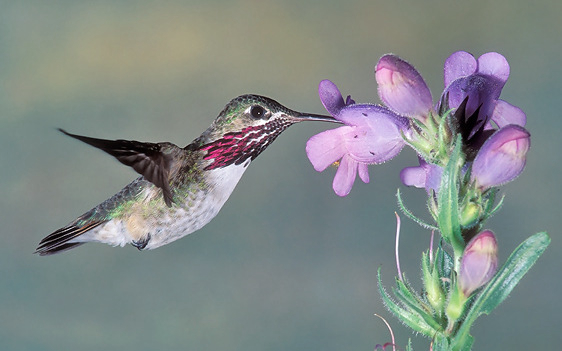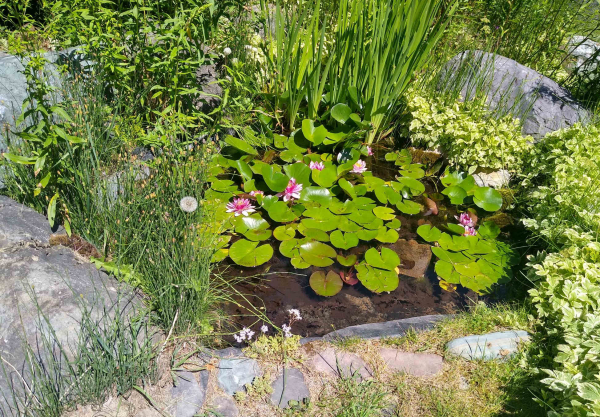
Calliope Hummingbirds were the big hit among the 4 species frequenting the cousins’ nectar feeders (photo by Brian E. Small).

Near Columbia Falls, Montana, cousin Matt’s water feature was a front yard attraction in his yard surrounded by mountain forest.

A young Red Crossbill photographed at Mick and Lanette’s feeding station as it stopped for sunflower seeds and fresh water (photo by Paul Konrad).
|
This week our editor is our guest Backyard Birding author: While attending a family wedding near Glacier National Park in northwest Montana, it turned out that our hosts had a great feeding station setup with nectar feeders, sunflower seeds, and suet, along with fresh water. Everyone enjoyed the birds, and it opened a line of conversation in which cousins related the birds attracted to their feeding stations, which I dearly appreciated and thought worthy of relating their stories, along with an update of my own feeding station, post-July.
Near Whitefish, Montana, cousins Lanette and Mick were great wedding hosts for the weekend, and they are super bird hosts throughout the year. Their 2 simple nectar feeders attracted more Calliope Hummingbirds in a couple hours that I’ve seen my entire life, plus Rufous, Broad-tailed, and Black-chinned Hummers. Pine Siskins were the primary seed eaters, but even more interesting were the young Red Crossbills, and the second day Mountain Chickadees were fairly regular too.
In the tops of the tall fir trees, there were also Steller’s Jays, Red-shafted Northern Flickers, Cedar Waxwings, and Eurasian Collared Doves. In Mick’s adjacent hayfield there was also a fledgling Red-tailed Hawk that could fly well but still could be heard food begging at times. A couple flybys by Turkey Vultures filled out the avian sightings during my 2-day stay, but the feeding station also provided interesting insights into other cousin’s home feeding stations in New Mexico and Arizona.
The day before I arrived, Mick and Lanette observed a colorful Western Tanager at their bird bath, which made me suggest a new food to attract more tanagers and perhaps Bullock’s Orioles – grape jelly. So Mick gave it a try the next day, but there were no takers during the couple days I was present, but it takes a while, and as post-nesting dispersal and fall migration begins, perhaps jelly will add a new dimension to their feeding station, as it has at mine. Another exciting insight from Mick was that Pileated Woodpeckers occasionally feed at their double suet feeders!
Alamogordo, New Mexico
Living just a few blacks away from one another in Alamogordo, New Mexico, cousins Barb and Jan were excited to share their feeder birds. Barb and Dan, along with Jan and Allen, enjoy visits from 3 species of orioles – Scott’s, Hooded, and Bullock’s Orioles that utilize nectar feeders each couple’s landscaped yards punctuated by beautiful collections of native cacti and agave. Hummingbirds also common in their yards, with the same species as we watched in at the Whitefish cousins’ feeders – Rufous, Calliope, Black-chinned, and Broad-tailed Hummingbirds.
House Finches are another species found in their yard, along with regular family groups and flocks of Gambel’s Quail. Jan added that White-winged Doves tend to visit their pond for drinks during late afternoon. Barb noted that she and Dan occasionally have had Greater Roadrunners in their yard, which Barb was surprised to find were such assassins, occasionally preying on other birds. She also described an adult roadrunner bringing a fledgling into their yard one season. Barb and Dan re-freshen the water in their bird bath about 3 times a day, plus when their sprinkling system turns on, they enjoy watching hummingbirds flying through the spray, bathing and drinking in the process. Jan and Allen are proud of their backyard water feature, a sizable pond complete with a waterfall that quenches lots of avian thirsts.
Paul’s Feeder Changes
One of the concerns I had about leaving home for a week was how abandoning the feeders would affect the orioles and other birds that visited my feeding station. When I returned, I quickly loaded up my jelly feeders and sliced an orange to replace what was left of the last one, thereby hopefully visually alerting orioles that the feeding station was open for business again. Within an hour I had a visit from a Gray Catbird, then 2; plus a couple House Finches.
The next day, last Wednesday, reality set in though when no Baltimore or Orchard Orioles were to be seen; same Thursday, but Friday afternoon I caught sight of a male Baltimore feasting on jelly. A closer look showed that it was a yearling male molting into adult plumage and missing many feathers across its body, tail, and wings. I hoped it would return, but by Saturday night I relinquished that this was a dispersing male, which is what I expected to see through the month of August.
Alas, it was kinda hurtful to know that my absence affected the 10 to 14 orioles that were visiting my feeding station to potentially disperse from the area a bit prematurely – not on their own terms like other summers, but because the jelly ran out . . . dang. But then again, maybe they were overly dependent on my feeders; certainly, there is an abundance of insects and other natural food resources in my yard and the surrounding area. That was underlined by the fact that during almost every visit by a Gray Catbird to the feeders, the bird had an insect that it dipped in the jelly, creating sweet bugs I guess. It seemed pretty clear, that the catbirds were feeding nestlings – a second brood no doubt.
Wednesday and Friday, I had at least one visit by a Ruby-throated Hummingbird, but didn’t see it/them feed at my nectar feeder. Sunday I had a hummingbird visit, but it was clear this dynamo was hunting for small insects and spiders, ignoring the nectar feeder too. It will probably be a couple weeks before hummingbirds assemble here in earnest, but the birds observed this week are indicative of a post-nesting dispersal.
A direct indicator of this dispersal, and possibly an indicator of the earliest migrating warblers, was the appearance of a delicate little female or fledgling Yellow Warbler, colored in muted yellow-olive back with cream-yellow belly plumage – an exciting first sighting of the changing season. But the continued presence of the species, with one stopping at the summer suet and another perching on the base of the bird bath, indicated there were probably more than one warbler; maybe a small loose flock. And after writing that, a male Yellow Warbler with faded plumage perched on the jelly feeder and nectar feeder, on the hunt for small insects and catching at least one. Not long thereafter a female perched on the nectar feeder, then dropped down to the bird bath to bathe a few moments – wonderful.
Yellow Warblers continued to make the feeders and bird bath part of an apparent route that included my adjacent elm tree and sumacs, and a chokecherry bush – all in search of bugs, and that action continued periodically throughout the daylight hours. It was fun to see how small and delicate these little birds are, and it’s noteworthy to mention that a south wind Saturday switched to a north wind Sunday, which was probably bringing new birds into my realm.
Ten minutes before the warblers, I a White-breasted Nuthatch stop at my feeding station, twice, so I quickly re-installed my suet feeder with a fresh no-melt “hot pepper” summer suet cake that birds prefer but that repels squirrels and other small mammals. When installing the suet feeder, I also removed 2 of my 3 jelly feeders – it’s clear that one will be plenty for now. Within 30 minutes a fledgling female Downy Woodpecker was feeding on the suet cake – hooray! A half-hour later a molting adult female Downy perched on the birch branch I provide as a decorative natural perch on the edge of my feeding station, then transferred to the suet feeder – my feeding station was alive again!
That’s when a female Baltimore Oriole dived into the suet feeder. This oriole could have been one of the yearling females that were daily visitors before my mountain trip, along with a yearling Baltimore that fed on jelly 45 minutes later – hmm. I hoped more will filter in more often now, returning birds and new birds. Indeed, the yearling oriole, or a couple of them, continue to stop for jelly since then, and I’ll keep you posted on new arrivals
While this has been a different Backyard Birding article than our usual how-to types of topics, we thought that by providing you with some examples of bird feeding stations with a description of the birds and foods at each, including changes at my feeders, you may find some ideas that may be helpful during this period when birds are dispersing to new locations, and perhaps even initiating early migrations. Be ready by providing fresh water, a variety of foods but emphasizing nectar, jelly, sliced oranges, suet, thistle seeds, black oil sunflower seeds, and roll with it, while being ready to add or remove foods as conditions in your yard indicate. Most of all, enjoy the birds that you attract, watch for new birds to appear, and enjoy this beautiful period of the year.
Article by Paul Konrad
Share your backyard birding experiences and photos at editorstbw2@gmail.com